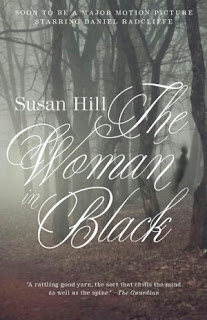Review: The Woman in Black, by Susan Hill
 |
| The Woman in Black by Susan Hill Vintage (reprint ed.) |
Those words don't exactly get tossed around lightly, and Kipps doesn't exactly catch on: determined to get his promotion, Kipps rallies and spends a handful of frightful days and nights at Eel Marsh House. The residence exists on its own kind of island in the marshlands; it is only accessible at low tide, via the Nine Lives Causeway (are you seeing a symbolism pattern here? Nine Lives Causeway, Eel Marsh House, Mrs. Drablow?) I'm certain that some of my own trepidation while reading was due in part to my familiarity with the story, but that speaks, nonetheless, of Hill's gift for thrilling her reader.
A short 176 pages, The Woman in Black is a page-turner that packs a quick hard punch in the gut of anyone who's ever feared that bump in the night, gasped at the rocking chair in the nursery that seems to move of its own volition, or needed to fast-forward past the swingset in the opening credits of "Are You Afraid of the Dark?" (i.e. me)
I have not yet had the opportunity to read or see Stephen Mallatratt's stage play adaptation of the novel, a production of which has been running in London's West End since 1989, but my understanding (from friends who have had that chance) is that it's a fairly faithful adaptation, utilizing a similar story-within-a-story device as the novel. I have, however, seen the most recent film adaptation. Twice. It's not really as faithful, as there are some major changes and additions. The thing about film in general is that you don't need to put in extra effort to creep out your viewer. Especially with this kind of source material, wherein Hill manages to send chills down one's spine with just words; she doesn't need a soundtrack in a minor key, or gore, or a muddy handprint on the front door (saw the movie and didn't catch that the first time? me too.)
 |
| It's too far away so you can't see it in this picture, but go back and watch the movie. When Kipps first arrives at Eel Marsh House. Muddy handprint on the door. |
If you didn't like the film (too gruesome? too much emphasis on creepy ghost children?) don't let that dissuade you from reading the book. The novel is milder, more straightforward, and will still give you that spine tingle you desire without the Hollywood excess.

Comments
Post a Comment
Any and all feedback is welcome - thanks for taking the time!